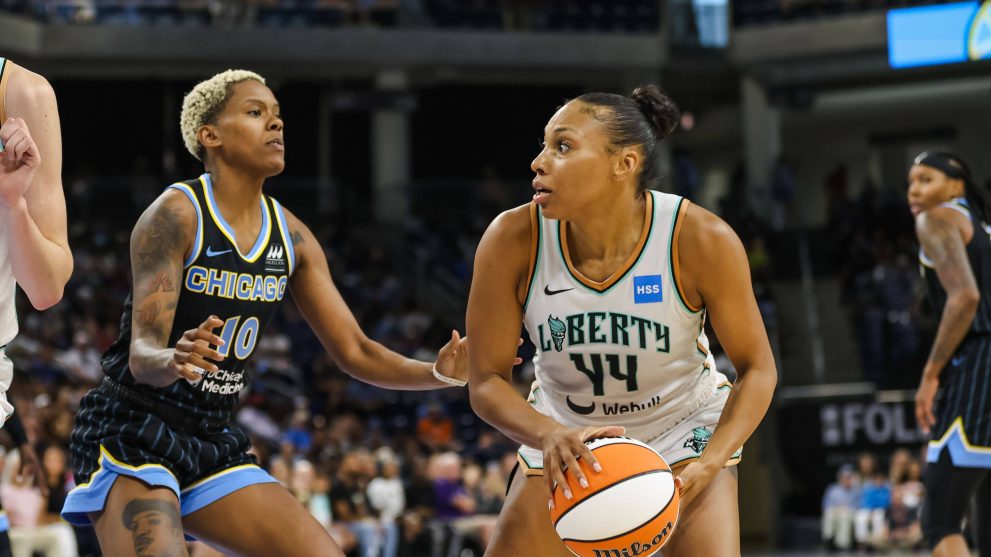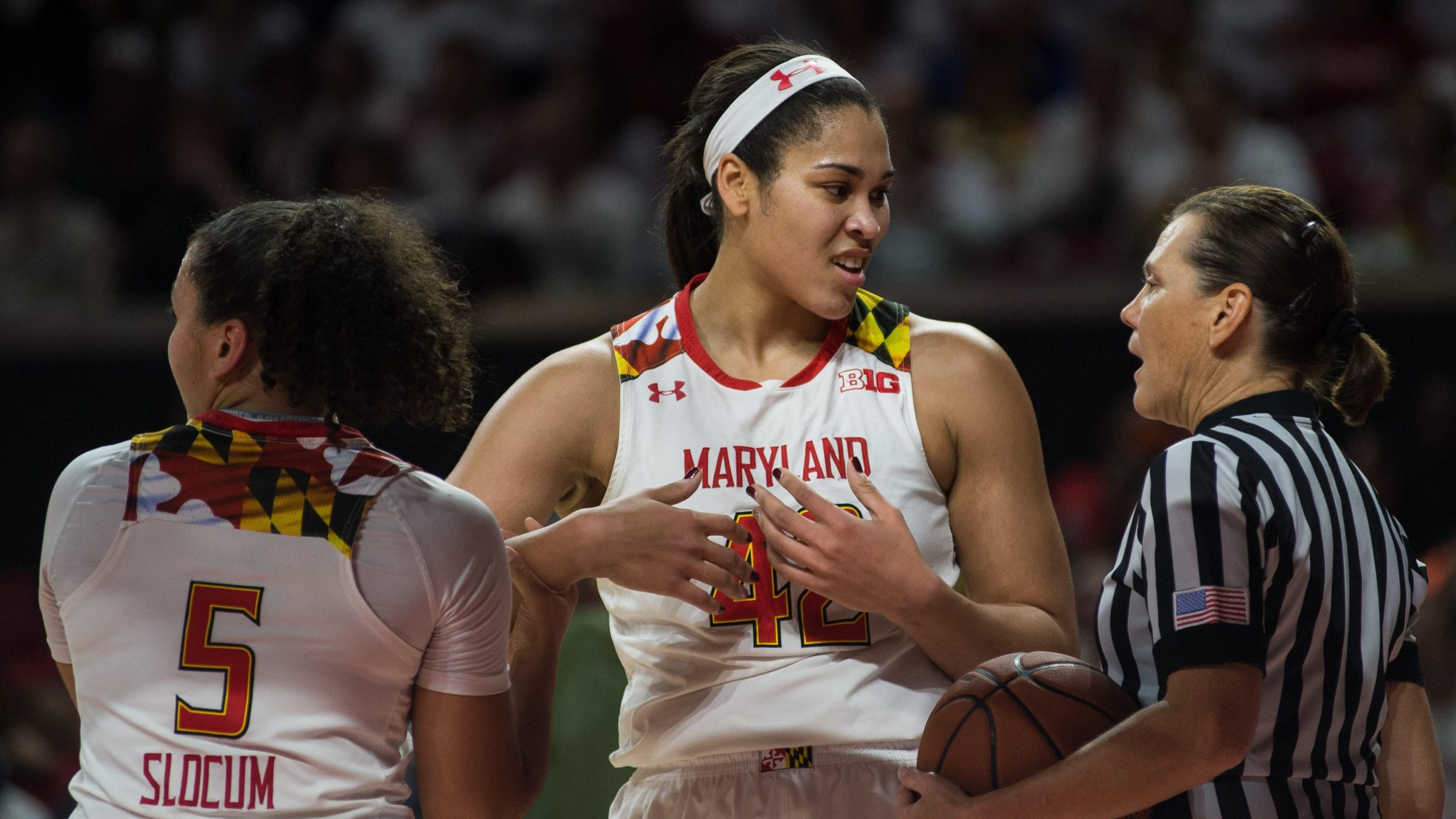DALLAS – The New York Liberty are 17-3 since the All-Star break, boasting the best record in the league, the largest point differential, and an offense that would rank first in league history (111.8 offensive rating). To say the Liberty are clicking and firing on all cylinders would be an understatement.
New York leads the league widely in assist rate: 71.7% of all baskets have been assisted since the All-Star break, with the Sun the next closest team at 67.9%. While the stat doesn’t tell the full story, it paints with a highlighting stroke, indicative of the ball movement this team has worked into and rhythm they’re in.
The Liberty play largely out of the flow; they set an initial action and progress towards their best looks through continual movement, either by body or ball. They’ll call out secondary plays if the initial is completely stalled, but typically are playing free with intuition as soon as the ball swings.
It seems minute, but that makes the fifth player in a lineup for all intents and purposes, the most vital.
When the ball stops, motion is killed, and the defense can reset. Why does the ball stop? Due to help principles which have to be abided against the Liberty (and any pro team playing out of ball screens), there will always be a player that gets helped off of. That’s natural. With how often the Liberty play through star guard Courtney Vandersloot, with screens set by Breanna Stewart and Jonquel Jones, and Sabrina Ionescu lurking and roaming for secondary attacks and providing a moving outside threat, Betnijah Laney is most often situated in the far corner of a play.
Laney, a former All-Star herself, is perhaps having the finest season of her career, in large part due to how vital she is for this team. That you don’t notice her in her role at times on the offensive end is a testament to how well she’s playing it.
“I keep telling B (Betnijah) she’s grown so much,” says Liberty Head Coach Sandy Brondello.
“When you’ve got really good players all coming together, number one, they have to all buy in and know there’s going to be sacrifice, and they did that. We want everyone to have a piece of the pie, that’s how we’re going to have our best success and it was a journey just to get there.”
The far corner/weak side corner is the primary help point in ball screen coverage, as that player will slide over into the paint, cover the basket, and then the defense will scramble from there in most base schemes.
That makes taking advantage of that coverage essential for teams playing in the flow.
When Laney gets helped off of, she has options; stay in the corner and fire up the open shot, duck in and post up a mismatch on a cut to the post if the timing is right, attack the closeout if the defense rotates hard when the ball is kicked to her, or swing the ball if not much of an advantage is created by the first ball-handler.
You can’t hesitate, you can’t question yourself, you can’t make the wrong decisions; Laney has hit a sublime balance as a ball mover, shooting threat, playmaker, and mismatch attacker that virtually every team in the league has struggled to find answers for. She unlocks the very best version of the Liberty.
The most important person on this team is Betnijah Laney. The Queen of the chessboard.
— Kevin Lewis (@kdotlew3H) September 6, 2023
“For B, it was, ok, you’re going to shoot a lot of threes, you’re gonna be a great defensive player, but we want you in transition,” Brondello said. “Now we’re finding areas where we can post her up and then get the ball to her on second and third side and make decisions with the ball in her hands, and that’s not easy you know, because her role has changed, but I think it’s made her an even better player. I’m really proud of her, because we wouldn’t be where we are today without what she brings on both ends of the floor.”
Since the start of August (13 games, Liberty 12-1), Laney is averaging 15.4 points per and 2.7 assists per game while shooting 38.5% from deep on four attempts per game. She has a 63.3% true-shooting clip across that span, nearly ten percent more efficient than league average (53.9%).
Amongst 78 players who average at least one transition possession per game, Laney ranks 5th in transition efficiency according to Synergy Sports tracking data.
She’s taking the highest percentage of shots at the rim and from three in her career, nearly two thirds of her total shots (65.5%) while shooting well above average on volume from both areas of the floor. 71.3% off all of Laney’s made baskets inside the arc have been assisted, a stark contrast from the first five seasons of her career where less than half of her two-pointers were unassisted (44.2%).
Laney still does the things that make her an excellent player, and that made her a star, but it goes without saying that her role is drastically different from what it’s ever been as a professional.
Last night’s nationally televised win over the Dallas Wings, one of the best games of the W season, was exemplary of Laney’s impact and how she asserts herself within New York’s offense. When the Wings had answers and a gameplan for the Liberty, Laney found ways early and often to drive a stake into the heart of it, molding and adapting as the game developed.
To start the game, Dallas cross-matched Arike Ogunbowale onto Laney, moving Satou Sabally onto the ball to put added length on the perimeter. New York immediately took notice and attacked on the first possession.
***For reference: Cross-matching is putting a player on an assignment defensively that isn’t their primary defender on the other end. Hence, a cross-match, as they are “crossing over” matchups.
The Liberty start off with a dribble handoff for Laney from Stewart, and then Stewart clears to the strong side corner (taking the best help defender on the Wings in Natasha Howard into a place she likely won’t help into the lane). Vandersloot initially looks to dive, but then sets a backscreen for Laney who cuts over to set up Ogunbowale into the screen. Crystal Dangerfield momentarily hangs back to give Ogunbowale room to recover, but at this point, the floor is already cleared for an outright size and strength matchup advantage in which the defense isn’t set; easy bucket.
Into the second quarter after quite a few post-ups and duck ins from Laney, she’s operating out of the corner again. Ogunbowale helps into the lane to deter the post-entry to Kayla Thornton who has a post mismatch herself, and instead the ball is skipped to Laney.
It’s simple, but it’s quick, it’s effective, and there’s no hesitation.
It almost comes down to a math problem; Laney is shooting 42.9% from the corners, an exceptional clip. Do you want to short the closeout and try to make it a one and done possession, living and dying by the shot as a defense? or, do you want to allow Laney to drive the lane, force help again, and keep scrambling? That equation doesn’t exist to the extremes it does if Laney doesn’t mix the perfect blend that she has.
A few possessions later, Laney draws the hard closeout in a deeper shot clock.
Even with stronger defense from Ogunbowale, Laney scans momentarily and attacks, threatening with the potential of a kickout, but punishing with the interior screen and seal from Jonquel Jones to score at the rim.
The Wings then moved Sabally onto Laney as New York has exploited that cross-match early and often, making it a pressure point even if Laney wasn’t scoring on every look. Sabally helps as Laney lifts to the slot, and she then drives the lane as Ogunbowale switches back onto her and scores fluidly off the jump stop and fade.
Later in the game, Laney takes advantage in transition blending in her post-up to take advantage of her size again, scoring the and-1.
The last play stands out the most, a perfect illustration of how New York has made life difficult for defense.
Laney brings the ball up and initiates the set, a hand-off for Ionescu. Dangerfield is sticking to Ionescu and hard denying the ball, so Ionescu sets the screen and flares instead. Laney moves the ball to Stef Dolson and Laney points towards the middle of the court to move the ball back through Ionsecu. Dolson and Ionescu operate through two player game in the slot as Kayla Thornton tells Jocelyn Willoughby to lift to the slot, and calls for Laney to clear to the opposite corner, setting the exit screen on the primary help defender.
Laney times her baseline cut right as Dolson screens for Ionescu and you can tell right away the strain this puts on Sabally. She automatically checks Laney’s cut, but doesn’t want to fully vacate as Dolson could be wide open on the roll on a pocket pass given how the screen was set and how high the Wings played Teaira McCowan. She slinks along and closes hard after McCowan starts to recover, but it’s already enough of a gap that gives Laney the open shot.
By all technicalities, Natasha Howard is the primary help defender, but the exit screen and action makes it murky, especially considering the angle of the screen and what it presents attacking the middle of the floor. Sabally’s assignment is Laney, but again, the help principles are made sort of murky.
That’s all to say that the Liberty are working at such a level where they can tweak on the fly and present more complex problems that a defense has t solve in real time, and that’s not easy. Betnijah Laney is arguably the key for why they can play with such freedom and flexibility while also hindering the freedom and flexibility the opposing defense has.
There’s a beauty in what Laney brings and provides, pushing the New York Liberty to the max while starring in role that doesn’t often get shine.







